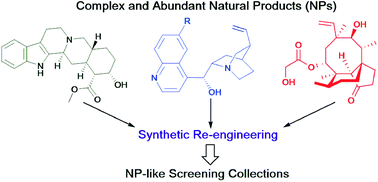Re-engineering natural products to engage new biological targets
Abstract
Covering: up to 2020
Natural products have a long history in drug discovery, with their inherent biological activity often tailored by medicinal chemists to arrive at the final drug product. This process is illustrated by numerous examples, including the conversion of epothilone to ixabepilone, erythromycin to azithromycin, and lovastatin to simvastatin. However, natural products are also fruitful starting points for the creation of complex and diverse compounds, especially those that are markedly different from the parent natural product and accordingly do not retain the biological activity of the parent. The resulting products have physiochemical properties that differ considerably when compared to traditional screening collections, thus affording an opportunity to discover novel biological activity. The synthesis of new structural frameworks from natural products thus yields value-added compounds, as demonstrated in the last several years with multiple biological discoveries emerging from these collections. This Highlight details a handful of these studies, describing new compounds derived from natural products that have biological activity and cellular targets different from those evoked/engaged by the parent. Such re-engineering of natural products offers the potential for discovering compounds with interesting and unexpected biological activity.

- This article is part of the themed collection: Synthetic strategies for mining the information-rich content of natural products


 Please wait while we load your content...
Please wait while we load your content...